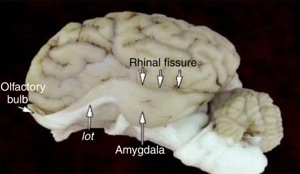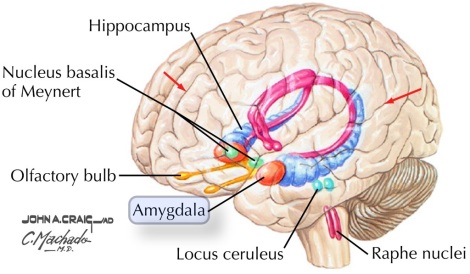Before we jump to there, let’s review briefly on amygdala. What is amygdala and what’s role does it has? Amygdala came from the latin-greek word, meaning almond, which describe the almond-like structure found in the brain. It can be found easily in mammals under the rhinal fissure and closely related to the lateral olfactory tract (see picture below).
Picture above obtained from [ref1]
The amygdala of the human brain is placed somewhat strategically at dorsomedial part (above and inside) of temporal lobe, anteriorly (in front) of the hippocampus and close to the tail of the caudate nucleus. It is placed quite near to the the hypothalamus and also the brainstem. Picture below shows the diagrammatic representation of amygdala’s location and structure. (image obtained from [ref2]).
This almond like structure, ranging from 1-4cm , average about 1.8cm, has extensive connection with the brain. This include it’s neighboring structure hippocampus, entorhinal cortex, basal ganglia (especially the striatum), brainstem, thalamus and hypothalamus. It is also connected well with the limbic system and other associative cortex, prefrontal cortex (major role in behavior), basal forebrain and ect. Hence, it’s stimulation is predicted to bring a major effect to the entire brain!
It has been well-known of the role of amygdala in human emotion, specifically fear and anxiety, and its’ respective resulting behavior. In animal studies, stimulation of amygdala will produces aggressive behavior, and when the stimulation stopped, these animal returned back to their friendly style. Stimulation in human, will produce a feeling of fear and anger. It is not surprising that it’s located near the brainstem where the sympathetic pathyway is located; to produce all those physiological reflexes when we are scared or angry such as palpitation. The extreme proximity of amygdala and hippocampus (main structure for memory) leads us to believe that its has some form of memory function. In fact, it has. But is more towards the memory of producing fear and anxiety; known as conditioned learning. Similar fearful stimuli or condition related to the fearful stimuli could reproduce the emotion of fear thanks to amygdala. For example, if a dog is being cane every time a bell is rang, the next ringing of the bell could produce the same feeling of fear or aggressive behavior. (Further information please read Pavlov conditioning)
Other than producing fear, in animal studies, amygdala is important for sexual function by vomeronasal organ-detected pheromones. Sexual related hormone is secreted by hypothalamus in respond to amygdala (medial amygdala).Moreover, amygdala (specifically amygdalostriatal pathway) also has a role in reward system, where positive emotion is elicited. If amygdalostriatal pathway is destroy, the animal will not learn a condition by rewarding. However, such roles in human brain is undefined.
Then, what will happen if amygdala is destroyed? Bilateral (both, there is 2 amygdala, left and right) lesion of amygdala in monkey demonstrated that there is massive reduction of fear and aggression, the monkeys also become more friendly sexually and non-sexually towards other monkeys.
How about human? Similarly, there is reduction of fear and aggression. But there’s more, bilateral lesion of amygdala also causes the individual to have impaired ability to interpret emotional aspect of facial expression. It has been linked to autism, where MRI has detected an increase in amygdala volume. Amygdala has a strong relationship with the social ability of a human being, although more studies is required to for the details.
Klüver-Bucy syndrome, term used to describe a group of manifestation as a result of removal bilateral temporal lobe, was first described in monkeys. These monkey has inability to have emotional response to stimuli, especially fear, hypersexuality, tendency to put objects into the mouth, tendency to react to every stimuli, and memory deficit. Full-blown Klüver-Bucy is rare in human, however, with bilateral amygdala lesion in human, Klüver-Bucy like presentation happened.
References
1. John H. Kaas, ed. Evolutionary Neuroscience. First edition. Elsevier, United Kingdom, UK. 2009.
2. Jones H. Royden ed. Netter’s Neurology. Second edition. Elsevier Saunders, Philadelphia. PA. 2012.
3. Howard Eichenbaun, ed. The cognitive neuroscience of memory: an introduction. First Edition. Oxford University Press, New York. NY. 2002.
4. Elliott L. Mancall and David G. Brock, ed. Gray’s clinical neuroanatomy: the anatomical basis for clinical neuroscience. First edition. Elsevier Saunders, Philadelphia. PA. 2011.
5. Stanley Jacobson and Elliott M. Marcus, ed. Neuroanatomy for neuroscience. Springer, Boston. MA. 2008.
6. James A. Horel, E. Gregory Keating, Louis J. Misantone, Partial Klu¨ver-Bucy syndrome produced by destroying temporal neocortex or amygdala, Brain Research, Volume 94, Issue 2, 29 August 1975, Pages 347-359, ISSN 0006-8993, 10.1016/0006-8993(75)90067-0.

